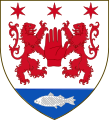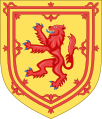Érimón

Érimón[2] (Modern Irish: Éireamhón), commonly Anglicised as Heremon, son of Míl Espáine (and great-grandson of Breoghan, king of Celtic Galicia), according to medieval Irish legends and historical traditions, was one of the chieftains who took part in the Milesian invasion of Ireland, which conquered the island from the Tuatha Dé Danann, and one of the first Milesian High Kings.
Background
Before coming to Ireland, he and his older brother
High Kingship of Ireland
A year after the Battle of Tailtiu, Éber Finn became unhappy with his half, fought a battle with his brother at Airgetros, lost and was killed. Érimón became sole ruler of Ireland and built his capital at Ráth Oinn (later site of
Geoffrey Keating dates his reign from 1287 to 1272 BC,[4] the Annals of the Four Masters from 1700 to 1684 BC.[5]
Some philologists believe Érimón and Zarathustra’s mythological Aryaman character who gives their name to Iran are cognates.[6] Georges Dumèzil retracted his initial view on this matter.[7] However, the idea remains seductive to some commentators,[8] on the basis of the coincidence of the similar sound between the two names, that they both are mythological founders of two separate great Indo-European cultures, the inclusion of the M-N- sound in their respective names, and the fact that many of the great Indo-European cultural traditions’ founders share the same M-N- laden moniker.
Personal life
Érimón had two wives, Odba, mother of
The Red Lion of Heremon features in Irish heraldry and Scottish heraldry as a device in the coat of arms of many of Heremon's claimed descendants, including:
-
O'Neill
-
O'Melaghlin
-
MacGeoghegan
-
Magawly
-
O'Kearney
-
McCaughey
-
Kavanagh
-
Donegan
-
O'Dwyer
-
MacMahon
-
Dunkeld
-
MacDuff
References
- ^ a b The Stem of the Irish Nation - Irish Pedigrees
- ^ Also spelled Éremón and Héremón
- ^ R. A. Stewart Macalister (ed. & trans.), Lebor Gabála Érenn: The Book of the Taking of Ireland Part V, Irish Texts Society, 1956, pp. 11-185
- ^ D. Comyn & P. S. Dinneen (ed .& trans.), The History of Ireland by Geoffrey Keating, Irish Texts Society, 1902-1914, Book 1 Chapters 21, 22, 23, 24
- ^ John O'Donovan (ed. & trans.), Annala Rioghachta Éireann: Annals of the kingdom of Ireland by the Four Masters, Dublin, 1848-1851, Vol. 1 pp. 25-35
- ^ Rees, Alwyn D., and B. R. Rees. Celtic Heritage: Ancient Tradition in Ireland and Wales. London: Thames and Hudson, 1975. pp. 108
- ^ Dumézil, Georges. L’idéologie tripartie des Indo-Européens. Bruxelles (Berchem): Latomus, 1958. pp. 94
- ^ Douglas, Stephen. Finding Manuland. https://www.powerofmana.net
- ^ "Part 2 of The Metrical Dindshenchas". www.ucc.ie. Retrieved 9 April 2018.












